Customer Value Management: Strategies and Analysis Report
VerifiedAdded on 2020/09/03
|15
|4220
|33
Report
AI Summary
This report provides a comprehensive analysis of Customer Value Management (CVM), focusing on the strategies and components essential for determining and measuring Customer Lifetime Value (CLV). The report explores various components of CLV, including customer churn rate, lifespan, retention rate, and profit margins, offering both historic and predictive methods for calculation. It examines factors influencing CLV, such as product quality, pricing, and economic conditions. The report further delves into market segmentation strategies, including demographic and behavioral approaches, and evaluates B2C and B2B decision-making models to identify customer value creation opportunities. The report also explores techniques for enhancing customer relationships and loyalty, concluding with a summary of key findings and recommendations for a home-based company. The report underscores the importance of CVM in building healthy customer relationships, increasing profitability, and fostering long-term business growth.
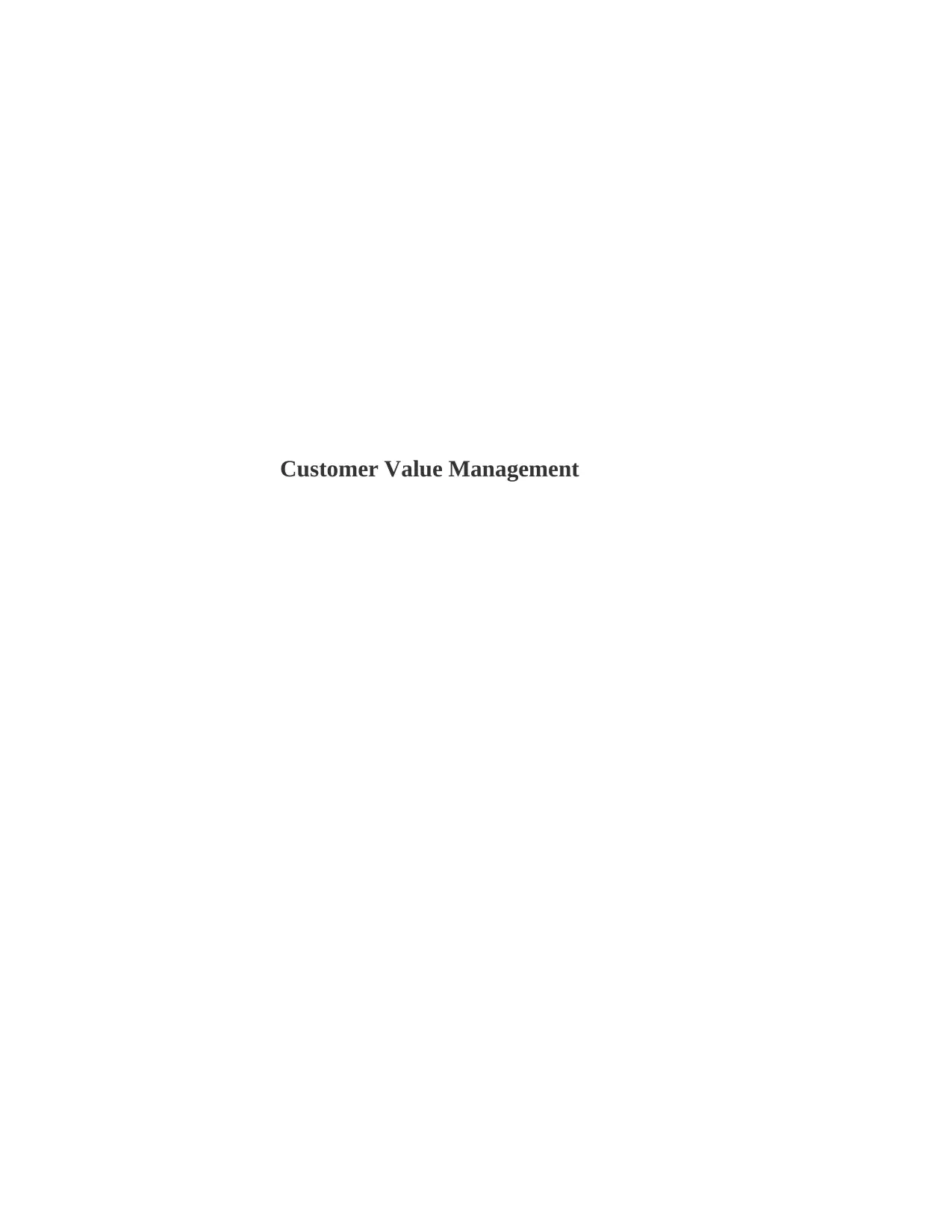
Customer Value Management
Paraphrase This Document
Need a fresh take? Get an instant paraphrase of this document with our AI Paraphraser
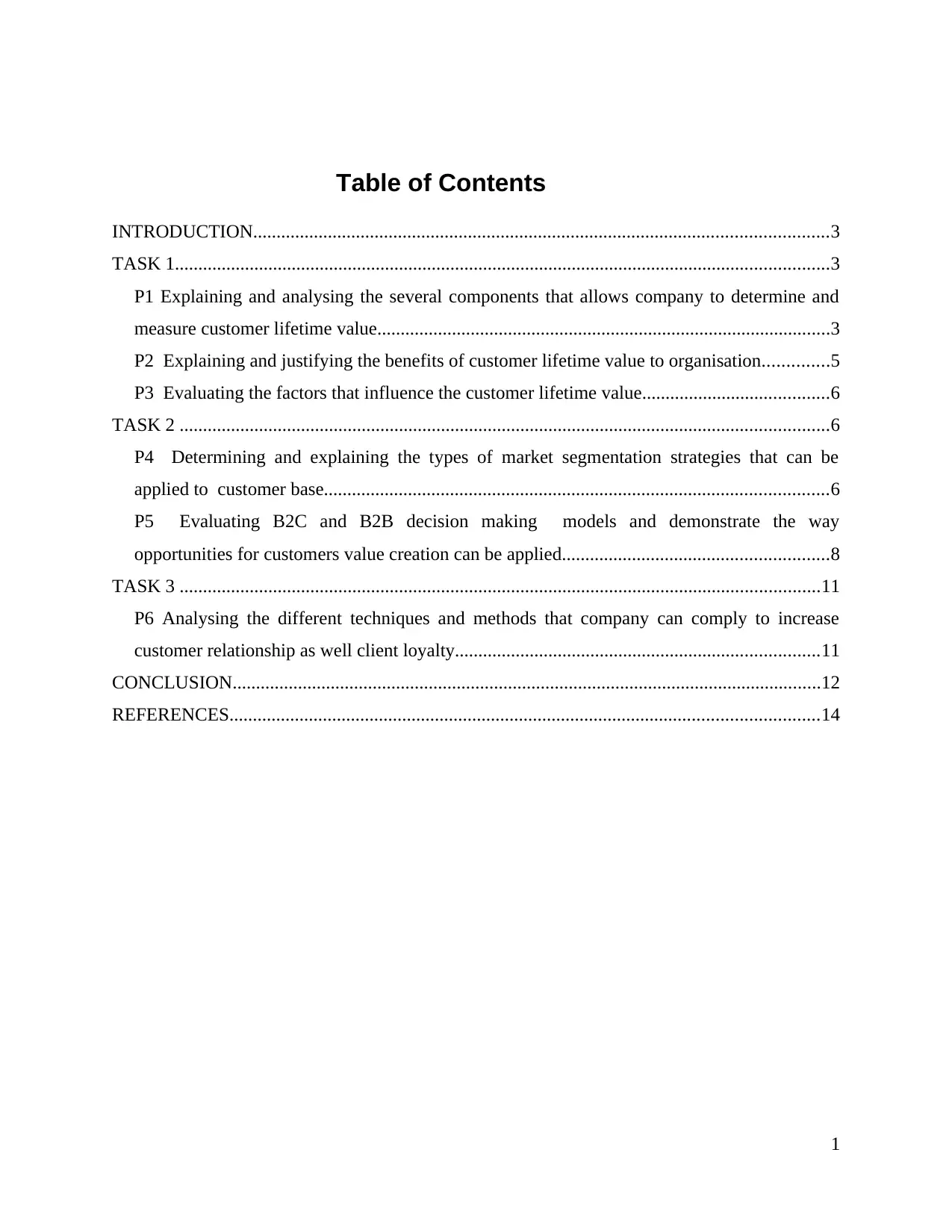
Table of Contents
INTRODUCTION...........................................................................................................................3
TASK 1............................................................................................................................................3
P1 Explaining and analysing the several components that allows company to determine and
measure customer lifetime value.................................................................................................3
P2 Explaining and justifying the benefits of customer lifetime value to organisation..............5
P3 Evaluating the factors that influence the customer lifetime value........................................6
TASK 2 ...........................................................................................................................................6
P4 Determining and explaining the types of market segmentation strategies that can be
applied to customer base............................................................................................................6
P5 Evaluating B2C and B2B decision making models and demonstrate the way
opportunities for customers value creation can be applied.........................................................8
TASK 3 .........................................................................................................................................11
P6 Analysing the different techniques and methods that company can comply to increase
customer relationship as well client loyalty..............................................................................11
CONCLUSION..............................................................................................................................12
REFERENCES..............................................................................................................................14
1
INTRODUCTION...........................................................................................................................3
TASK 1............................................................................................................................................3
P1 Explaining and analysing the several components that allows company to determine and
measure customer lifetime value.................................................................................................3
P2 Explaining and justifying the benefits of customer lifetime value to organisation..............5
P3 Evaluating the factors that influence the customer lifetime value........................................6
TASK 2 ...........................................................................................................................................6
P4 Determining and explaining the types of market segmentation strategies that can be
applied to customer base............................................................................................................6
P5 Evaluating B2C and B2B decision making models and demonstrate the way
opportunities for customers value creation can be applied.........................................................8
TASK 3 .........................................................................................................................................11
P6 Analysing the different techniques and methods that company can comply to increase
customer relationship as well client loyalty..............................................................................11
CONCLUSION..............................................................................................................................12
REFERENCES..............................................................................................................................14
1
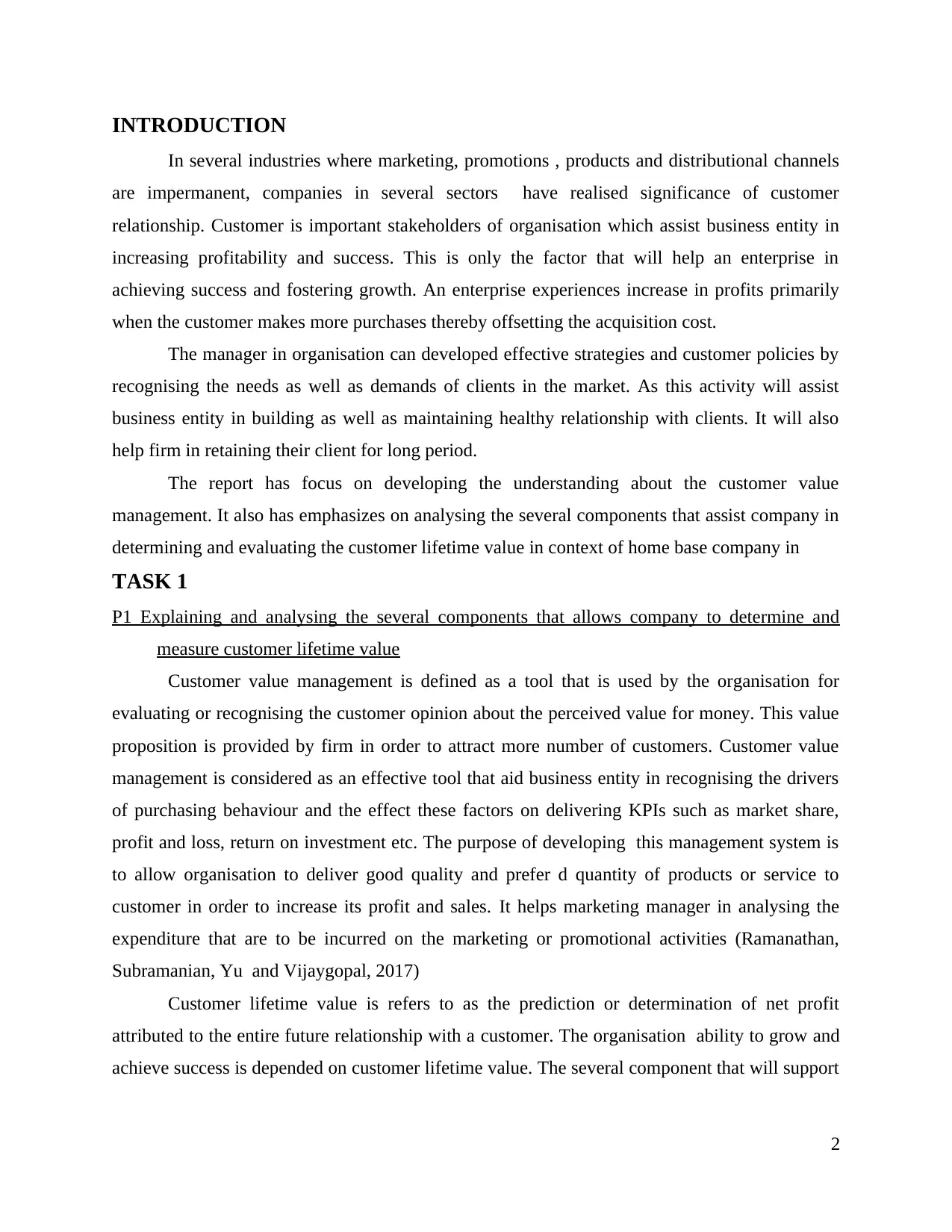
INTRODUCTION
In several industries where marketing, promotions , products and distributional channels
are impermanent, companies in several sectors have realised significance of customer
relationship. Customer is important stakeholders of organisation which assist business entity in
increasing profitability and success. This is only the factor that will help an enterprise in
achieving success and fostering growth. An enterprise experiences increase in profits primarily
when the customer makes more purchases thereby offsetting the acquisition cost.
The manager in organisation can developed effective strategies and customer policies by
recognising the needs as well as demands of clients in the market. As this activity will assist
business entity in building as well as maintaining healthy relationship with clients. It will also
help firm in retaining their client for long period.
The report has focus on developing the understanding about the customer value
management. It also has emphasizes on analysing the several components that assist company in
determining and evaluating the customer lifetime value in context of home base company in
TASK 1
P1 Explaining and analysing the several components that allows company to determine and
measure customer lifetime value
Customer value management is defined as a tool that is used by the organisation for
evaluating or recognising the customer opinion about the perceived value for money. This value
proposition is provided by firm in order to attract more number of customers. Customer value
management is considered as an effective tool that aid business entity in recognising the drivers
of purchasing behaviour and the effect these factors on delivering KPIs such as market share,
profit and loss, return on investment etc. The purpose of developing this management system is
to allow organisation to deliver good quality and prefer d quantity of products or service to
customer in order to increase its profit and sales. It helps marketing manager in analysing the
expenditure that are to be incurred on the marketing or promotional activities (Ramanathan,
Subramanian, Yu and Vijaygopal, 2017)
Customer lifetime value is refers to as the prediction or determination of net profit
attributed to the entire future relationship with a customer. The organisation ability to grow and
achieve success is depended on customer lifetime value. The several component that will support
2
In several industries where marketing, promotions , products and distributional channels
are impermanent, companies in several sectors have realised significance of customer
relationship. Customer is important stakeholders of organisation which assist business entity in
increasing profitability and success. This is only the factor that will help an enterprise in
achieving success and fostering growth. An enterprise experiences increase in profits primarily
when the customer makes more purchases thereby offsetting the acquisition cost.
The manager in organisation can developed effective strategies and customer policies by
recognising the needs as well as demands of clients in the market. As this activity will assist
business entity in building as well as maintaining healthy relationship with clients. It will also
help firm in retaining their client for long period.
The report has focus on developing the understanding about the customer value
management. It also has emphasizes on analysing the several components that assist company in
determining and evaluating the customer lifetime value in context of home base company in
TASK 1
P1 Explaining and analysing the several components that allows company to determine and
measure customer lifetime value
Customer value management is defined as a tool that is used by the organisation for
evaluating or recognising the customer opinion about the perceived value for money. This value
proposition is provided by firm in order to attract more number of customers. Customer value
management is considered as an effective tool that aid business entity in recognising the drivers
of purchasing behaviour and the effect these factors on delivering KPIs such as market share,
profit and loss, return on investment etc. The purpose of developing this management system is
to allow organisation to deliver good quality and prefer d quantity of products or service to
customer in order to increase its profit and sales. It helps marketing manager in analysing the
expenditure that are to be incurred on the marketing or promotional activities (Ramanathan,
Subramanian, Yu and Vijaygopal, 2017)
Customer lifetime value is refers to as the prediction or determination of net profit
attributed to the entire future relationship with a customer. The organisation ability to grow and
achieve success is depended on customer lifetime value. The several component that will support
2
⊘ This is a preview!⊘
Do you want full access?
Subscribe today to unlock all pages.

Trusted by 1+ million students worldwide
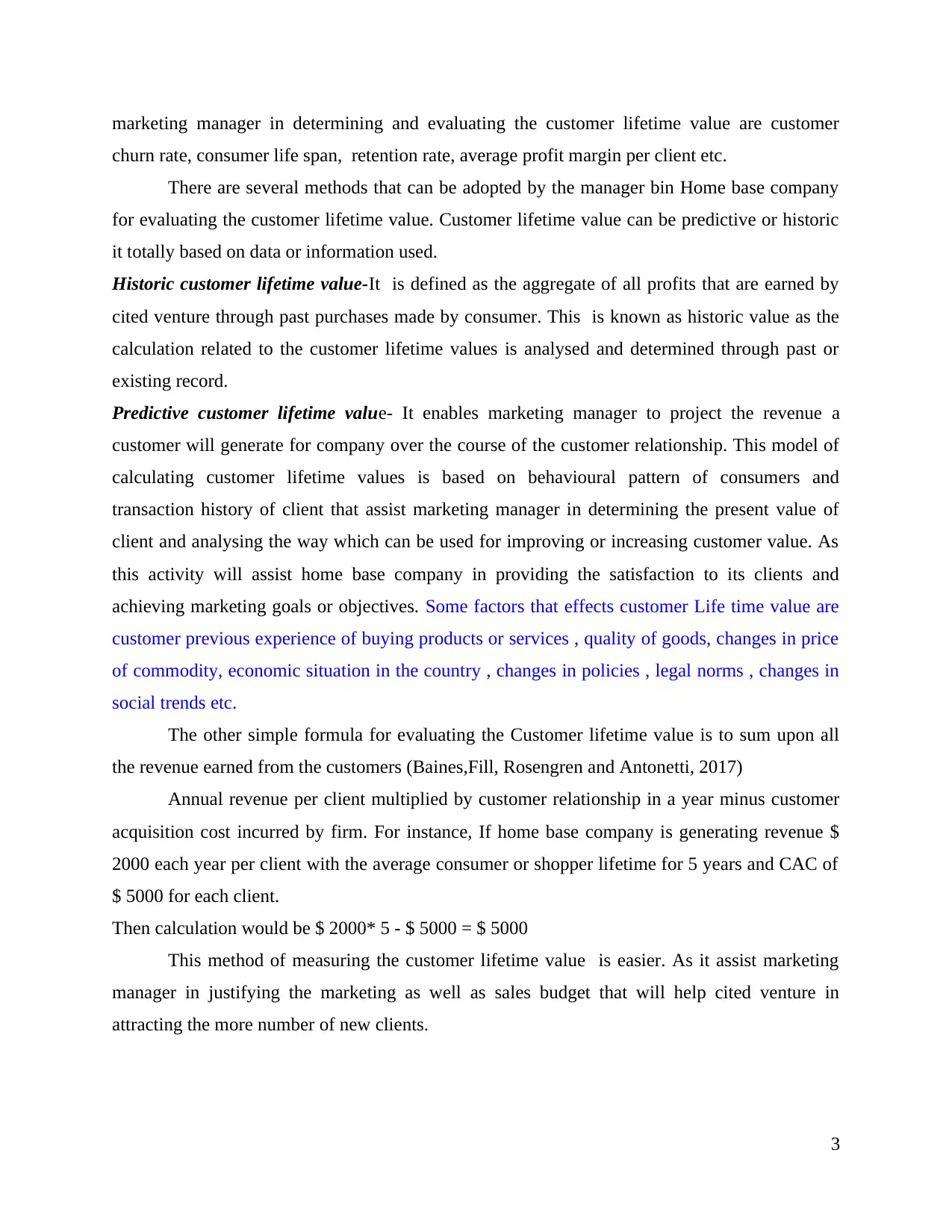
marketing manager in determining and evaluating the customer lifetime value are customer
churn rate, consumer life span, retention rate, average profit margin per client etc.
There are several methods that can be adopted by the manager bin Home base company
for evaluating the customer lifetime value. Customer lifetime value can be predictive or historic
it totally based on data or information used.
Historic customer lifetime value-It is defined as the aggregate of all profits that are earned by
cited venture through past purchases made by consumer. This is known as historic value as the
calculation related to the customer lifetime values is analysed and determined through past or
existing record.
Predictive customer lifetime value- It enables marketing manager to project the revenue a
customer will generate for company over the course of the customer relationship. This model of
calculating customer lifetime values is based on behavioural pattern of consumers and
transaction history of client that assist marketing manager in determining the present value of
client and analysing the way which can be used for improving or increasing customer value. As
this activity will assist home base company in providing the satisfaction to its clients and
achieving marketing goals or objectives. Some factors that effects customer Life time value are
customer previous experience of buying products or services , quality of goods, changes in price
of commodity, economic situation in the country , changes in policies , legal norms , changes in
social trends etc.
The other simple formula for evaluating the Customer lifetime value is to sum upon all
the revenue earned from the customers (Baines,Fill, Rosengren and Antonetti, 2017)
Annual revenue per client multiplied by customer relationship in a year minus customer
acquisition cost incurred by firm. For instance, If home base company is generating revenue $
2000 each year per client with the average consumer or shopper lifetime for 5 years and CAC of
$ 5000 for each client.
Then calculation would be $ 2000* 5 - $ 5000 = $ 5000
This method of measuring the customer lifetime value is easier. As it assist marketing
manager in justifying the marketing as well as sales budget that will help cited venture in
attracting the more number of new clients.
3
churn rate, consumer life span, retention rate, average profit margin per client etc.
There are several methods that can be adopted by the manager bin Home base company
for evaluating the customer lifetime value. Customer lifetime value can be predictive or historic
it totally based on data or information used.
Historic customer lifetime value-It is defined as the aggregate of all profits that are earned by
cited venture through past purchases made by consumer. This is known as historic value as the
calculation related to the customer lifetime values is analysed and determined through past or
existing record.
Predictive customer lifetime value- It enables marketing manager to project the revenue a
customer will generate for company over the course of the customer relationship. This model of
calculating customer lifetime values is based on behavioural pattern of consumers and
transaction history of client that assist marketing manager in determining the present value of
client and analysing the way which can be used for improving or increasing customer value. As
this activity will assist home base company in providing the satisfaction to its clients and
achieving marketing goals or objectives. Some factors that effects customer Life time value are
customer previous experience of buying products or services , quality of goods, changes in price
of commodity, economic situation in the country , changes in policies , legal norms , changes in
social trends etc.
The other simple formula for evaluating the Customer lifetime value is to sum upon all
the revenue earned from the customers (Baines,Fill, Rosengren and Antonetti, 2017)
Annual revenue per client multiplied by customer relationship in a year minus customer
acquisition cost incurred by firm. For instance, If home base company is generating revenue $
2000 each year per client with the average consumer or shopper lifetime for 5 years and CAC of
$ 5000 for each client.
Then calculation would be $ 2000* 5 - $ 5000 = $ 5000
This method of measuring the customer lifetime value is easier. As it assist marketing
manager in justifying the marketing as well as sales budget that will help cited venture in
attracting the more number of new clients.
3
Paraphrase This Document
Need a fresh take? Get an instant paraphrase of this document with our AI Paraphraser
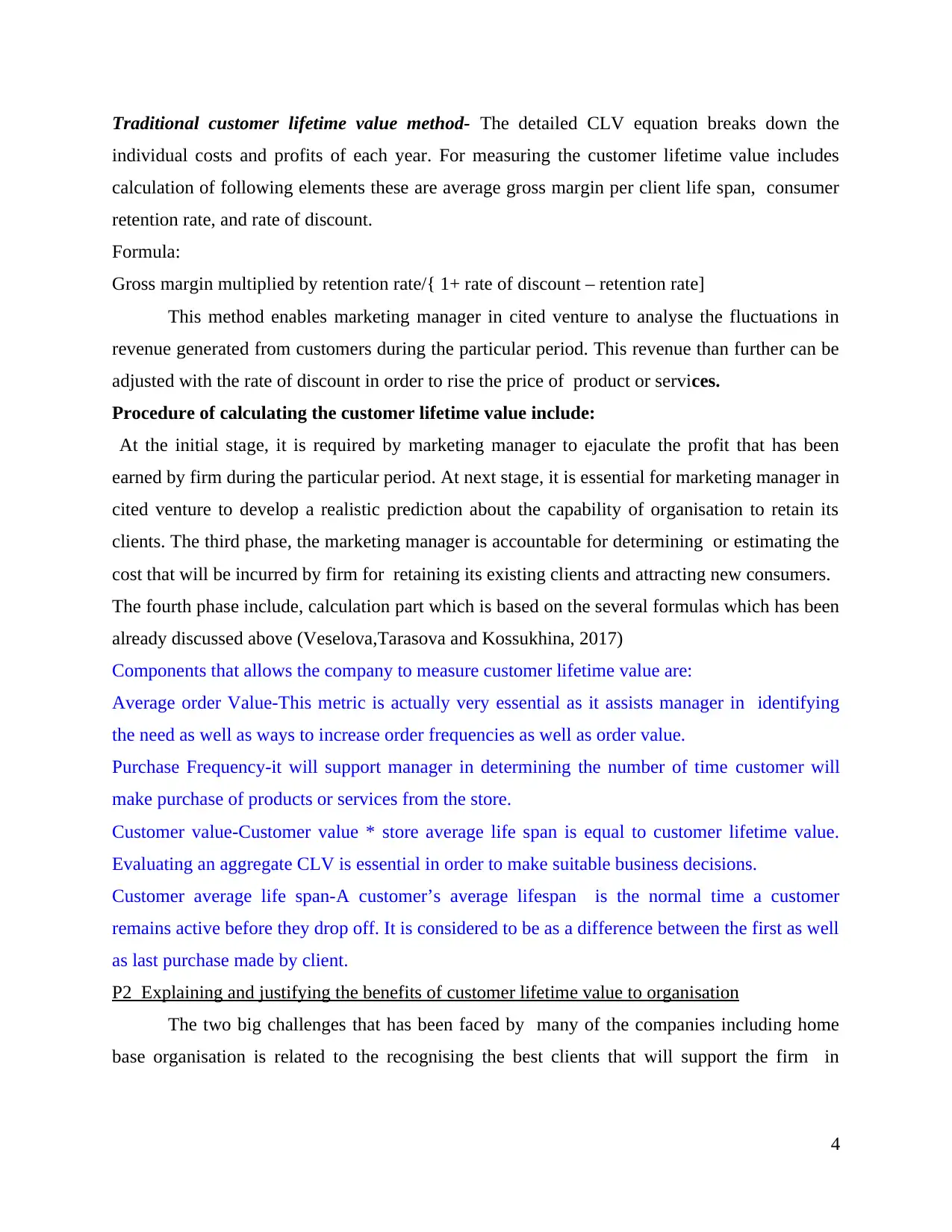
Traditional customer lifetime value method- The detailed CLV equation breaks down the
individual costs and profits of each year. For measuring the customer lifetime value includes
calculation of following elements these are average gross margin per client life span, consumer
retention rate, and rate of discount.
Formula:
Gross margin multiplied by retention rate/{ 1+ rate of discount – retention rate]
This method enables marketing manager in cited venture to analyse the fluctuations in
revenue generated from customers during the particular period. This revenue than further can be
adjusted with the rate of discount in order to rise the price of product or services.
Procedure of calculating the customer lifetime value include:
At the initial stage, it is required by marketing manager to ejaculate the profit that has been
earned by firm during the particular period. At next stage, it is essential for marketing manager in
cited venture to develop a realistic prediction about the capability of organisation to retain its
clients. The third phase, the marketing manager is accountable for determining or estimating the
cost that will be incurred by firm for retaining its existing clients and attracting new consumers.
The fourth phase include, calculation part which is based on the several formulas which has been
already discussed above (Veselova,Tarasova and Kossukhina, 2017)
Components that allows the company to measure customer lifetime value are:
Average order Value-This metric is actually very essential as it assists manager in identifying
the need as well as ways to increase order frequencies as well as order value.
Purchase Frequency-it will support manager in determining the number of time customer will
make purchase of products or services from the store.
Customer value-Customer value * store average life span is equal to customer lifetime value.
Evaluating an aggregate CLV is essential in order to make suitable business decisions.
Customer average life span-A customer’s average lifespan is the normal time a customer
remains active before they drop off. It is considered to be as a difference between the first as well
as last purchase made by client.
P2 Explaining and justifying the benefits of customer lifetime value to organisation
The two big challenges that has been faced by many of the companies including home
base organisation is related to the recognising the best clients that will support the firm in
4
individual costs and profits of each year. For measuring the customer lifetime value includes
calculation of following elements these are average gross margin per client life span, consumer
retention rate, and rate of discount.
Formula:
Gross margin multiplied by retention rate/{ 1+ rate of discount – retention rate]
This method enables marketing manager in cited venture to analyse the fluctuations in
revenue generated from customers during the particular period. This revenue than further can be
adjusted with the rate of discount in order to rise the price of product or services.
Procedure of calculating the customer lifetime value include:
At the initial stage, it is required by marketing manager to ejaculate the profit that has been
earned by firm during the particular period. At next stage, it is essential for marketing manager in
cited venture to develop a realistic prediction about the capability of organisation to retain its
clients. The third phase, the marketing manager is accountable for determining or estimating the
cost that will be incurred by firm for retaining its existing clients and attracting new consumers.
The fourth phase include, calculation part which is based on the several formulas which has been
already discussed above (Veselova,Tarasova and Kossukhina, 2017)
Components that allows the company to measure customer lifetime value are:
Average order Value-This metric is actually very essential as it assists manager in identifying
the need as well as ways to increase order frequencies as well as order value.
Purchase Frequency-it will support manager in determining the number of time customer will
make purchase of products or services from the store.
Customer value-Customer value * store average life span is equal to customer lifetime value.
Evaluating an aggregate CLV is essential in order to make suitable business decisions.
Customer average life span-A customer’s average lifespan is the normal time a customer
remains active before they drop off. It is considered to be as a difference between the first as well
as last purchase made by client.
P2 Explaining and justifying the benefits of customer lifetime value to organisation
The two big challenges that has been faced by many of the companies including home
base organisation is related to the recognising the best clients that will support the firm in
4
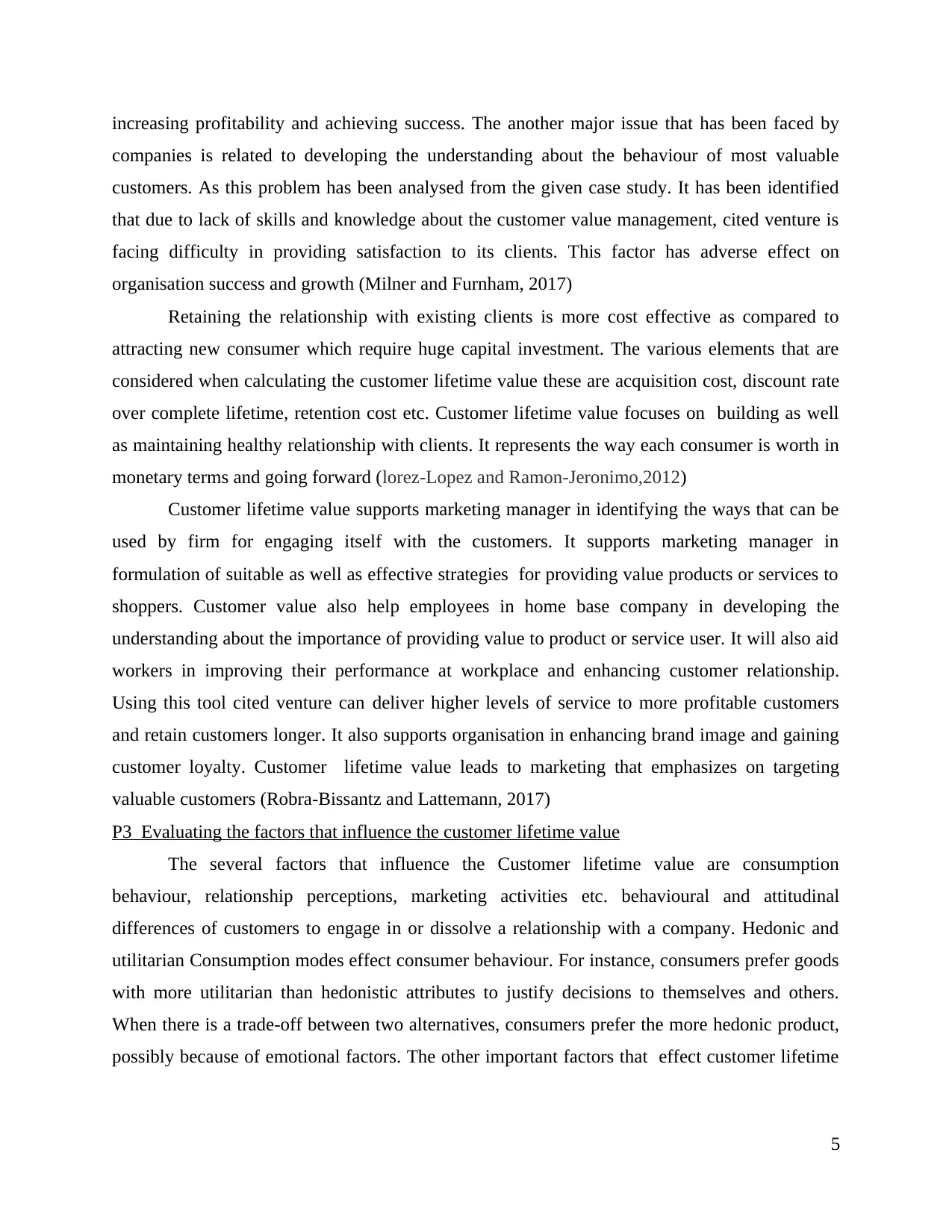
increasing profitability and achieving success. The another major issue that has been faced by
companies is related to developing the understanding about the behaviour of most valuable
customers. As this problem has been analysed from the given case study. It has been identified
that due to lack of skills and knowledge about the customer value management, cited venture is
facing difficulty in providing satisfaction to its clients. This factor has adverse effect on
organisation success and growth (Milner and Furnham, 2017)
Retaining the relationship with existing clients is more cost effective as compared to
attracting new consumer which require huge capital investment. The various elements that are
considered when calculating the customer lifetime value these are acquisition cost, discount rate
over complete lifetime, retention cost etc. Customer lifetime value focuses on building as well
as maintaining healthy relationship with clients. It represents the way each consumer is worth in
monetary terms and going forward (lorez-Lopez and Ramon-Jeronimo,2012)
Customer lifetime value supports marketing manager in identifying the ways that can be
used by firm for engaging itself with the customers. It supports marketing manager in
formulation of suitable as well as effective strategies for providing value products or services to
shoppers. Customer value also help employees in home base company in developing the
understanding about the importance of providing value to product or service user. It will also aid
workers in improving their performance at workplace and enhancing customer relationship.
Using this tool cited venture can deliver higher levels of service to more profitable customers
and retain customers longer. It also supports organisation in enhancing brand image and gaining
customer loyalty. Customer lifetime value leads to marketing that emphasizes on targeting
valuable customers (Robra-Bissantz and Lattemann, 2017)
P3 Evaluating the factors that influence the customer lifetime value
The several factors that influence the Customer lifetime value are consumption
behaviour, relationship perceptions, marketing activities etc. behavioural and attitudinal
differences of customers to engage in or dissolve a relationship with a company. Hedonic and
utilitarian Consumption modes effect consumer behaviour. For instance, consumers prefer goods
with more utilitarian than hedonistic attributes to justify decisions to themselves and others.
When there is a trade-off between two alternatives, consumers prefer the more hedonic product,
possibly because of emotional factors. The other important factors that effect customer lifetime
5
companies is related to developing the understanding about the behaviour of most valuable
customers. As this problem has been analysed from the given case study. It has been identified
that due to lack of skills and knowledge about the customer value management, cited venture is
facing difficulty in providing satisfaction to its clients. This factor has adverse effect on
organisation success and growth (Milner and Furnham, 2017)
Retaining the relationship with existing clients is more cost effective as compared to
attracting new consumer which require huge capital investment. The various elements that are
considered when calculating the customer lifetime value these are acquisition cost, discount rate
over complete lifetime, retention cost etc. Customer lifetime value focuses on building as well
as maintaining healthy relationship with clients. It represents the way each consumer is worth in
monetary terms and going forward (lorez-Lopez and Ramon-Jeronimo,2012)
Customer lifetime value supports marketing manager in identifying the ways that can be
used by firm for engaging itself with the customers. It supports marketing manager in
formulation of suitable as well as effective strategies for providing value products or services to
shoppers. Customer value also help employees in home base company in developing the
understanding about the importance of providing value to product or service user. It will also aid
workers in improving their performance at workplace and enhancing customer relationship.
Using this tool cited venture can deliver higher levels of service to more profitable customers
and retain customers longer. It also supports organisation in enhancing brand image and gaining
customer loyalty. Customer lifetime value leads to marketing that emphasizes on targeting
valuable customers (Robra-Bissantz and Lattemann, 2017)
P3 Evaluating the factors that influence the customer lifetime value
The several factors that influence the Customer lifetime value are consumption
behaviour, relationship perceptions, marketing activities etc. behavioural and attitudinal
differences of customers to engage in or dissolve a relationship with a company. Hedonic and
utilitarian Consumption modes effect consumer behaviour. For instance, consumers prefer goods
with more utilitarian than hedonistic attributes to justify decisions to themselves and others.
When there is a trade-off between two alternatives, consumers prefer the more hedonic product,
possibly because of emotional factors. The other important factors that effect customer lifetime
5
⊘ This is a preview!⊘
Do you want full access?
Subscribe today to unlock all pages.

Trusted by 1+ million students worldwide
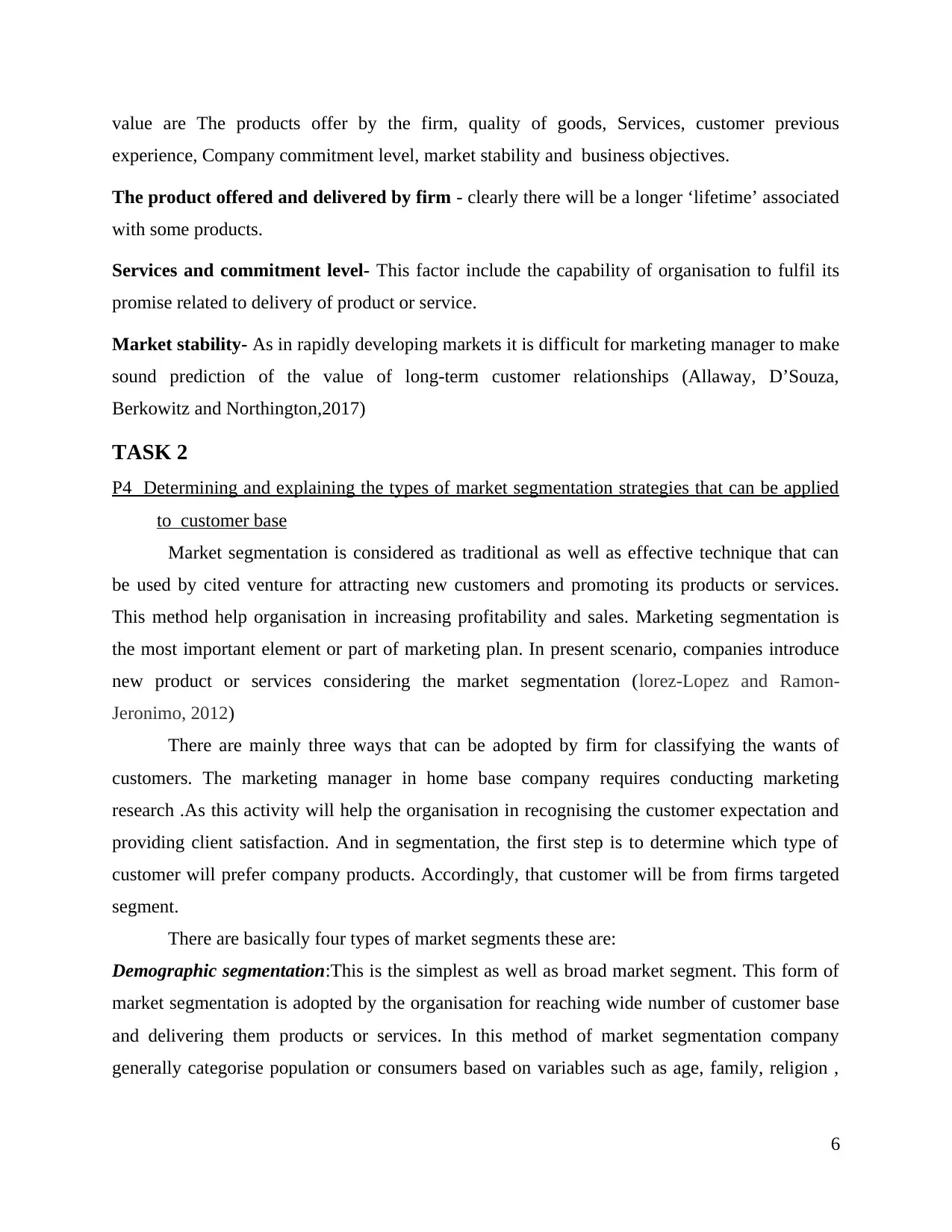
value are The products offer by the firm, quality of goods, Services, customer previous
experience, Company commitment level, market stability and business objectives.
The product offered and delivered by firm - clearly there will be a longer ‘lifetime’ associated
with some products.
Services and commitment level- This factor include the capability of organisation to fulfil its
promise related to delivery of product or service.
Market stability- As in rapidly developing markets it is difficult for marketing manager to make
sound prediction of the value of long-term customer relationships (Allaway, D’Souza,
Berkowitz and Northington,2017)
TASK 2
P4 Determining and explaining the types of market segmentation strategies that can be applied
to customer base
Market segmentation is considered as traditional as well as effective technique that can
be used by cited venture for attracting new customers and promoting its products or services.
This method help organisation in increasing profitability and sales. Marketing segmentation is
the most important element or part of marketing plan. In present scenario, companies introduce
new product or services considering the market segmentation (lorez-Lopez and Ramon-
Jeronimo, 2012)
There are mainly three ways that can be adopted by firm for classifying the wants of
customers. The marketing manager in home base company requires conducting marketing
research .As this activity will help the organisation in recognising the customer expectation and
providing client satisfaction. And in segmentation, the first step is to determine which type of
customer will prefer company products. Accordingly, that customer will be from firms targeted
segment.
There are basically four types of market segments these are:
Demographic segmentation:This is the simplest as well as broad market segment. This form of
market segmentation is adopted by the organisation for reaching wide number of customer base
and delivering them products or services. In this method of market segmentation company
generally categorise population or consumers based on variables such as age, family, religion ,
6
experience, Company commitment level, market stability and business objectives.
The product offered and delivered by firm - clearly there will be a longer ‘lifetime’ associated
with some products.
Services and commitment level- This factor include the capability of organisation to fulfil its
promise related to delivery of product or service.
Market stability- As in rapidly developing markets it is difficult for marketing manager to make
sound prediction of the value of long-term customer relationships (Allaway, D’Souza,
Berkowitz and Northington,2017)
TASK 2
P4 Determining and explaining the types of market segmentation strategies that can be applied
to customer base
Market segmentation is considered as traditional as well as effective technique that can
be used by cited venture for attracting new customers and promoting its products or services.
This method help organisation in increasing profitability and sales. Marketing segmentation is
the most important element or part of marketing plan. In present scenario, companies introduce
new product or services considering the market segmentation (lorez-Lopez and Ramon-
Jeronimo, 2012)
There are mainly three ways that can be adopted by firm for classifying the wants of
customers. The marketing manager in home base company requires conducting marketing
research .As this activity will help the organisation in recognising the customer expectation and
providing client satisfaction. And in segmentation, the first step is to determine which type of
customer will prefer company products. Accordingly, that customer will be from firms targeted
segment.
There are basically four types of market segments these are:
Demographic segmentation:This is the simplest as well as broad market segment. This form of
market segmentation is adopted by the organisation for reaching wide number of customer base
and delivering them products or services. In this method of market segmentation company
generally categorise population or consumers based on variables such as age, family, religion ,
6
Paraphrase This Document
Need a fresh take? Get an instant paraphrase of this document with our AI Paraphraser
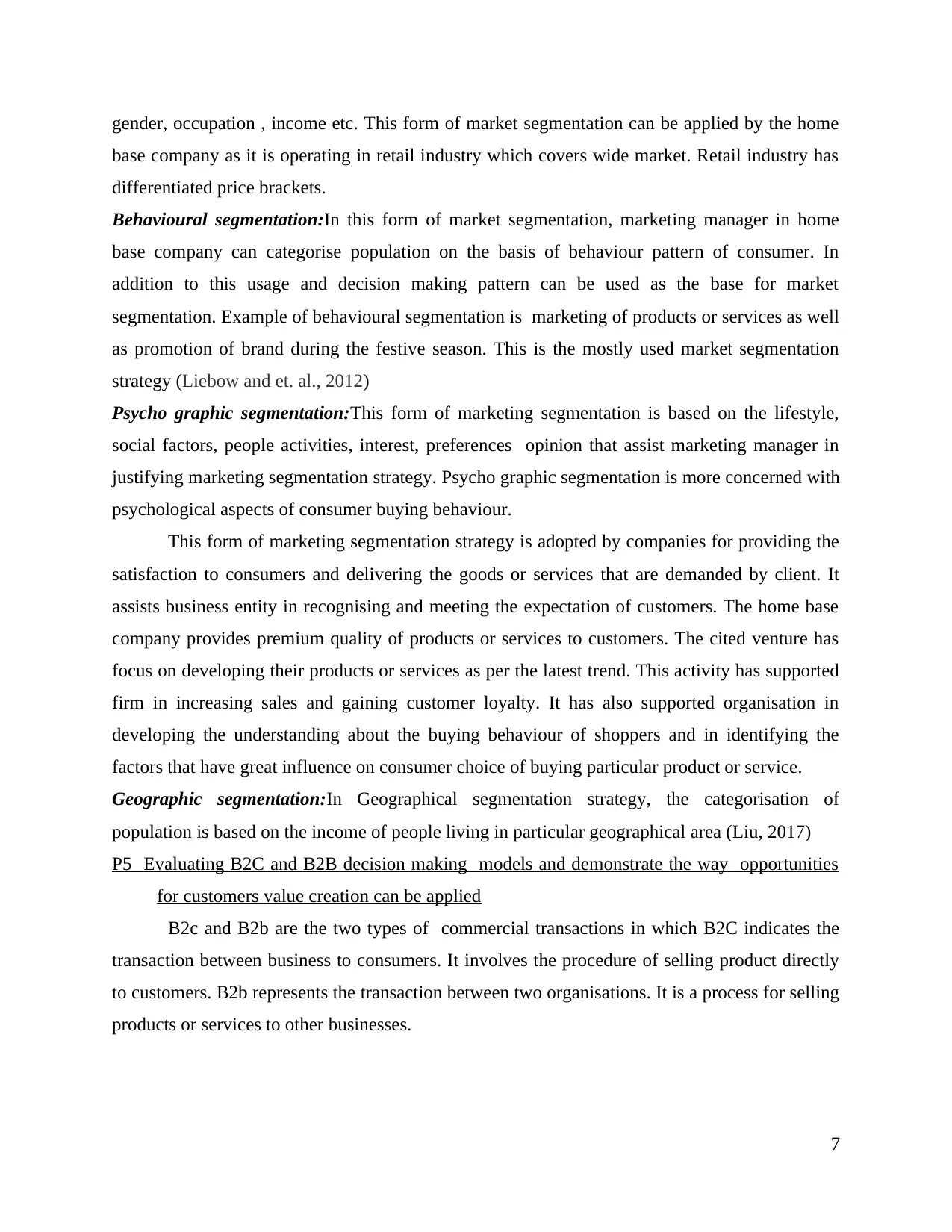
gender, occupation , income etc. This form of market segmentation can be applied by the home
base company as it is operating in retail industry which covers wide market. Retail industry has
differentiated price brackets.
Behavioural segmentation:In this form of market segmentation, marketing manager in home
base company can categorise population on the basis of behaviour pattern of consumer. In
addition to this usage and decision making pattern can be used as the base for market
segmentation. Example of behavioural segmentation is marketing of products or services as well
as promotion of brand during the festive season. This is the mostly used market segmentation
strategy (Liebow and et. al., 2012)
Psycho graphic segmentation:This form of marketing segmentation is based on the lifestyle,
social factors, people activities, interest, preferences opinion that assist marketing manager in
justifying marketing segmentation strategy. Psycho graphic segmentation is more concerned with
psychological aspects of consumer buying behaviour.
This form of marketing segmentation strategy is adopted by companies for providing the
satisfaction to consumers and delivering the goods or services that are demanded by client. It
assists business entity in recognising and meeting the expectation of customers. The home base
company provides premium quality of products or services to customers. The cited venture has
focus on developing their products or services as per the latest trend. This activity has supported
firm in increasing sales and gaining customer loyalty. It has also supported organisation in
developing the understanding about the buying behaviour of shoppers and in identifying the
factors that have great influence on consumer choice of buying particular product or service.
Geographic segmentation:In Geographical segmentation strategy, the categorisation of
population is based on the income of people living in particular geographical area (Liu, 2017)
P5 Evaluating B2C and B2B decision making models and demonstrate the way opportunities
for customers value creation can be applied
B2c and B2b are the two types of commercial transactions in which B2C indicates the
transaction between business to consumers. It involves the procedure of selling product directly
to customers. B2b represents the transaction between two organisations. It is a process for selling
products or services to other businesses.
7
base company as it is operating in retail industry which covers wide market. Retail industry has
differentiated price brackets.
Behavioural segmentation:In this form of market segmentation, marketing manager in home
base company can categorise population on the basis of behaviour pattern of consumer. In
addition to this usage and decision making pattern can be used as the base for market
segmentation. Example of behavioural segmentation is marketing of products or services as well
as promotion of brand during the festive season. This is the mostly used market segmentation
strategy (Liebow and et. al., 2012)
Psycho graphic segmentation:This form of marketing segmentation is based on the lifestyle,
social factors, people activities, interest, preferences opinion that assist marketing manager in
justifying marketing segmentation strategy. Psycho graphic segmentation is more concerned with
psychological aspects of consumer buying behaviour.
This form of marketing segmentation strategy is adopted by companies for providing the
satisfaction to consumers and delivering the goods or services that are demanded by client. It
assists business entity in recognising and meeting the expectation of customers. The home base
company provides premium quality of products or services to customers. The cited venture has
focus on developing their products or services as per the latest trend. This activity has supported
firm in increasing sales and gaining customer loyalty. It has also supported organisation in
developing the understanding about the buying behaviour of shoppers and in identifying the
factors that have great influence on consumer choice of buying particular product or service.
Geographic segmentation:In Geographical segmentation strategy, the categorisation of
population is based on the income of people living in particular geographical area (Liu, 2017)
P5 Evaluating B2C and B2B decision making models and demonstrate the way opportunities
for customers value creation can be applied
B2c and B2b are the two types of commercial transactions in which B2C indicates the
transaction between business to consumers. It involves the procedure of selling product directly
to customers. B2b represents the transaction between two organisations. It is a process for selling
products or services to other businesses.
7
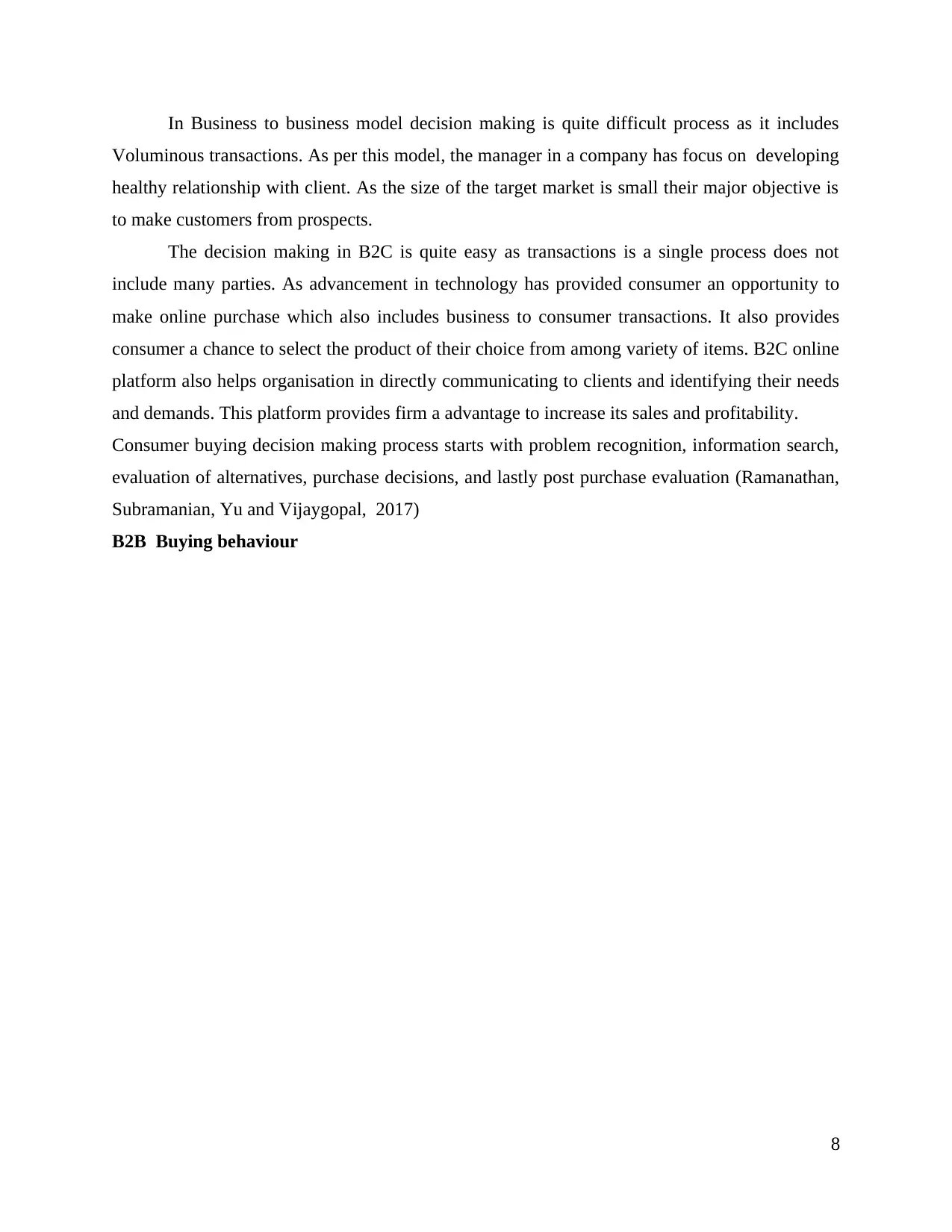
In Business to business model decision making is quite difficult process as it includes
Voluminous transactions. As per this model, the manager in a company has focus on developing
healthy relationship with client. As the size of the target market is small their major objective is
to make customers from prospects.
The decision making in B2C is quite easy as transactions is a single process does not
include many parties. As advancement in technology has provided consumer an opportunity to
make online purchase which also includes business to consumer transactions. It also provides
consumer a chance to select the product of their choice from among variety of items. B2C online
platform also helps organisation in directly communicating to clients and identifying their needs
and demands. This platform provides firm a advantage to increase its sales and profitability.
Consumer buying decision making process starts with problem recognition, information search,
evaluation of alternatives, purchase decisions, and lastly post purchase evaluation (Ramanathan,
Subramanian, Yu and Vijaygopal, 2017)
B2B Buying behaviour
8
Voluminous transactions. As per this model, the manager in a company has focus on developing
healthy relationship with client. As the size of the target market is small their major objective is
to make customers from prospects.
The decision making in B2C is quite easy as transactions is a single process does not
include many parties. As advancement in technology has provided consumer an opportunity to
make online purchase which also includes business to consumer transactions. It also provides
consumer a chance to select the product of their choice from among variety of items. B2C online
platform also helps organisation in directly communicating to clients and identifying their needs
and demands. This platform provides firm a advantage to increase its sales and profitability.
Consumer buying decision making process starts with problem recognition, information search,
evaluation of alternatives, purchase decisions, and lastly post purchase evaluation (Ramanathan,
Subramanian, Yu and Vijaygopal, 2017)
B2B Buying behaviour
8
⊘ This is a preview!⊘
Do you want full access?
Subscribe today to unlock all pages.

Trusted by 1+ million students worldwide
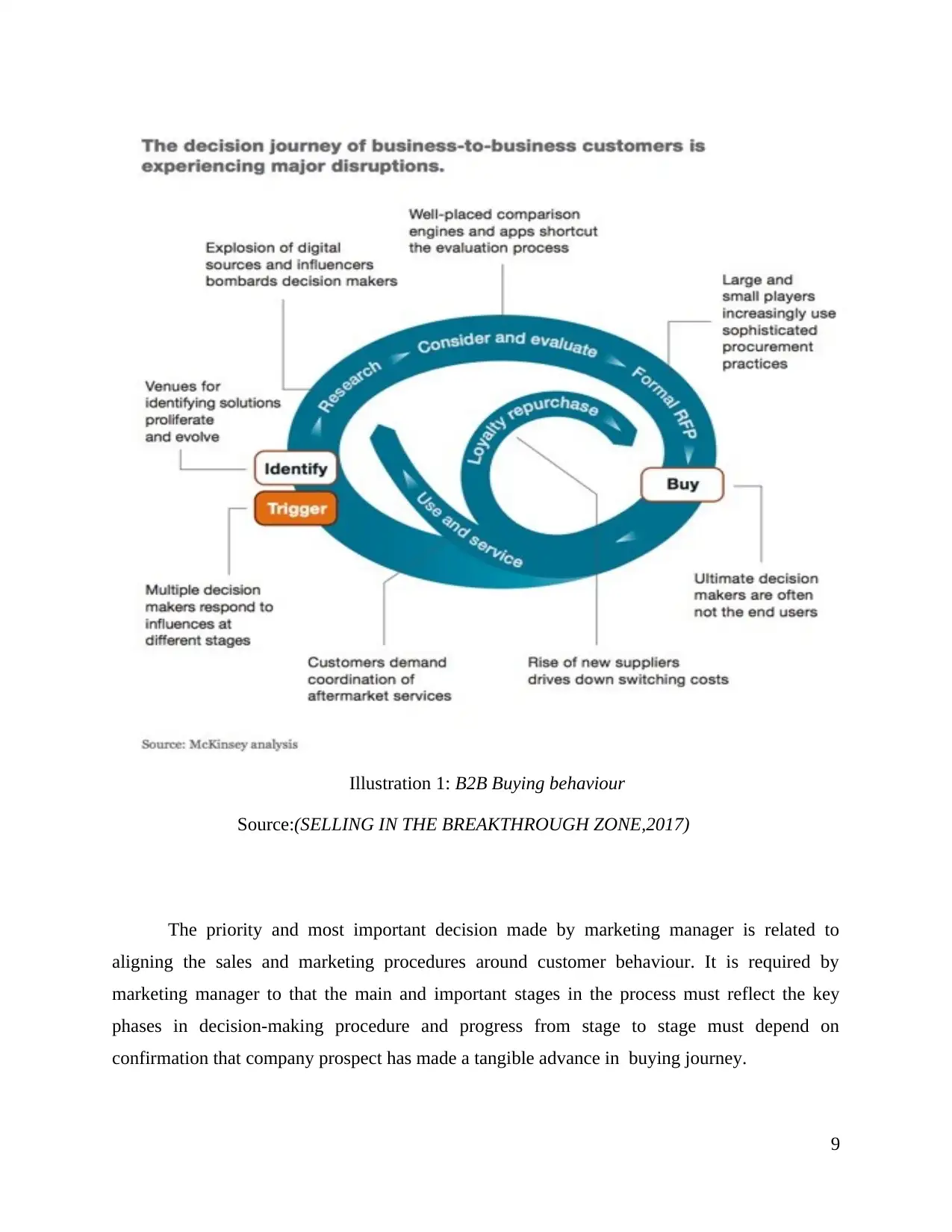
The priority and most important decision made by marketing manager is related to
aligning the sales and marketing procedures around customer behaviour. It is required by
marketing manager to that the main and important stages in the process must reflect the key
phases in decision-making procedure and progress from stage to stage must depend on
confirmation that company prospect has made a tangible advance in buying journey.
9
Illustration 1: B2B Buying behaviour
Source:(SELLING IN THE BREAKTHROUGH ZONE,2017)
aligning the sales and marketing procedures around customer behaviour. It is required by
marketing manager to that the main and important stages in the process must reflect the key
phases in decision-making procedure and progress from stage to stage must depend on
confirmation that company prospect has made a tangible advance in buying journey.
9
Illustration 1: B2B Buying behaviour
Source:(SELLING IN THE BREAKTHROUGH ZONE,2017)
Paraphrase This Document
Need a fresh take? Get an instant paraphrase of this document with our AI Paraphraser
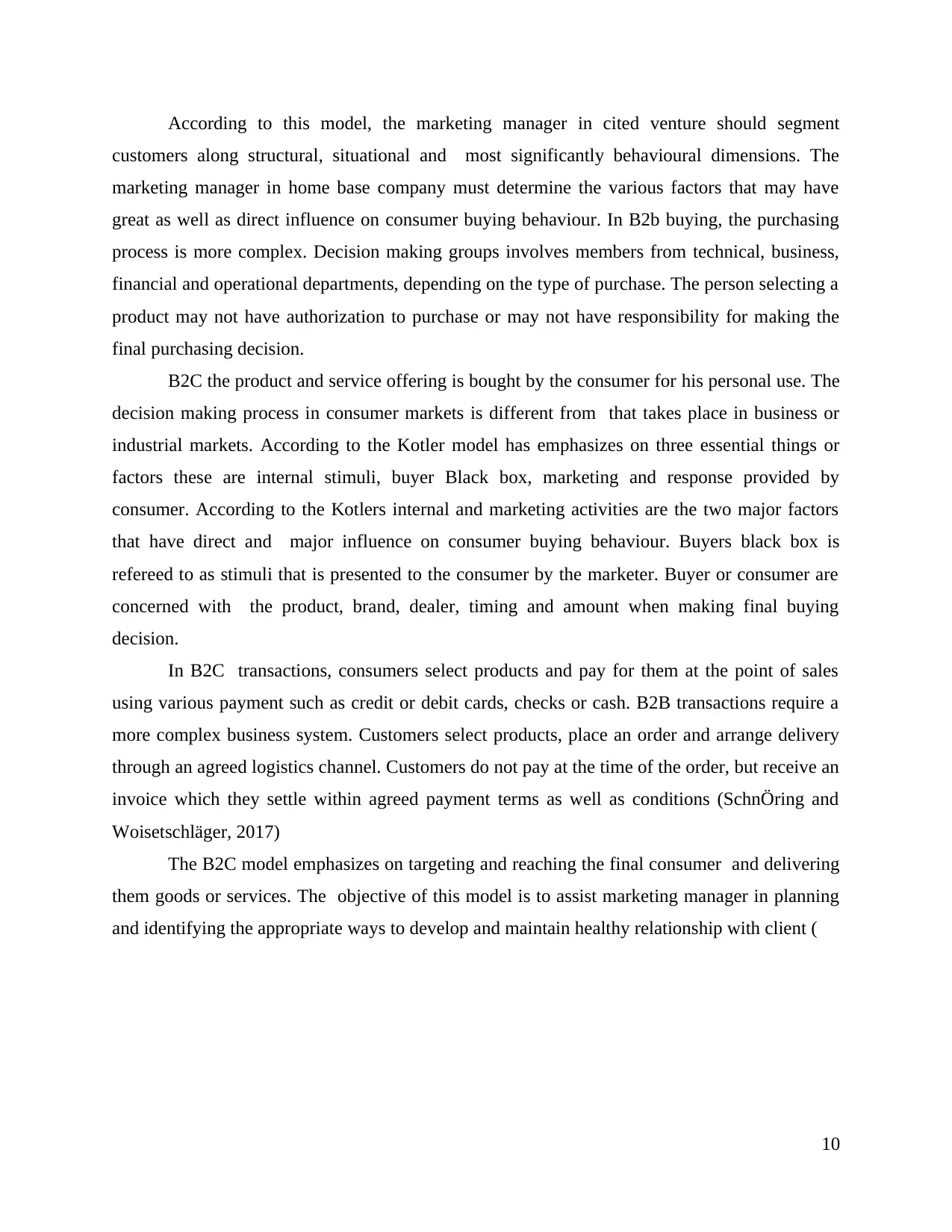
According to this model, the marketing manager in cited venture should segment
customers along structural, situational and most significantly behavioural dimensions. The
marketing manager in home base company must determine the various factors that may have
great as well as direct influence on consumer buying behaviour. In B2b buying, the purchasing
process is more complex. Decision making groups involves members from technical, business,
financial and operational departments, depending on the type of purchase. The person selecting a
product may not have authorization to purchase or may not have responsibility for making the
final purchasing decision.
B2C the product and service offering is bought by the consumer for his personal use. The
decision making process in consumer markets is different from that takes place in business or
industrial markets. According to the Kotler model has emphasizes on three essential things or
factors these are internal stimuli, buyer Black box, marketing and response provided by
consumer. According to the Kotlers internal and marketing activities are the two major factors
that have direct and major influence on consumer buying behaviour. Buyers black box is
refereed to as stimuli that is presented to the consumer by the marketer. Buyer or consumer are
concerned with the product, brand, dealer, timing and amount when making final buying
decision.
In B2C transactions, consumers select products and pay for them at the point of sales
using various payment such as credit or debit cards, checks or cash. B2B transactions require a
more complex business system. Customers select products, place an order and arrange delivery
through an agreed logistics channel. Customers do not pay at the time of the order, but receive an
invoice which they settle within agreed payment terms as well as conditions (SchnÖring and
Woisetschläger, 2017)
The B2C model emphasizes on targeting and reaching the final consumer and delivering
them goods or services. The objective of this model is to assist marketing manager in planning
and identifying the appropriate ways to develop and maintain healthy relationship with client (
10
customers along structural, situational and most significantly behavioural dimensions. The
marketing manager in home base company must determine the various factors that may have
great as well as direct influence on consumer buying behaviour. In B2b buying, the purchasing
process is more complex. Decision making groups involves members from technical, business,
financial and operational departments, depending on the type of purchase. The person selecting a
product may not have authorization to purchase or may not have responsibility for making the
final purchasing decision.
B2C the product and service offering is bought by the consumer for his personal use. The
decision making process in consumer markets is different from that takes place in business or
industrial markets. According to the Kotler model has emphasizes on three essential things or
factors these are internal stimuli, buyer Black box, marketing and response provided by
consumer. According to the Kotlers internal and marketing activities are the two major factors
that have direct and major influence on consumer buying behaviour. Buyers black box is
refereed to as stimuli that is presented to the consumer by the marketer. Buyer or consumer are
concerned with the product, brand, dealer, timing and amount when making final buying
decision.
In B2C transactions, consumers select products and pay for them at the point of sales
using various payment such as credit or debit cards, checks or cash. B2B transactions require a
more complex business system. Customers select products, place an order and arrange delivery
through an agreed logistics channel. Customers do not pay at the time of the order, but receive an
invoice which they settle within agreed payment terms as well as conditions (SchnÖring and
Woisetschläger, 2017)
The B2C model emphasizes on targeting and reaching the final consumer and delivering
them goods or services. The objective of this model is to assist marketing manager in planning
and identifying the appropriate ways to develop and maintain healthy relationship with client (
10
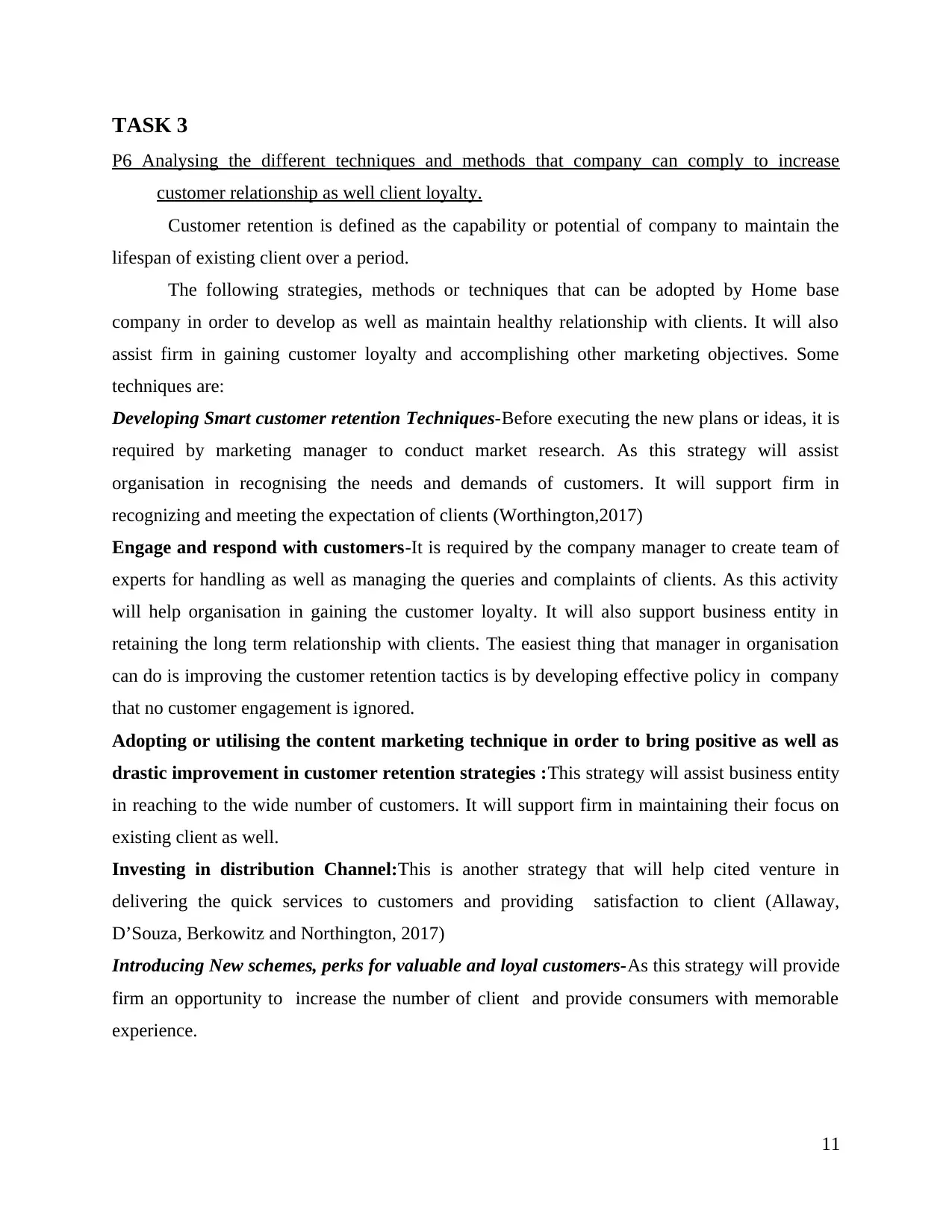
TASK 3
P6 Analysing the different techniques and methods that company can comply to increase
customer relationship as well client loyalty.
Customer retention is defined as the capability or potential of company to maintain the
lifespan of existing client over a period.
The following strategies, methods or techniques that can be adopted by Home base
company in order to develop as well as maintain healthy relationship with clients. It will also
assist firm in gaining customer loyalty and accomplishing other marketing objectives. Some
techniques are:
Developing Smart customer retention Techniques-Before executing the new plans or ideas, it is
required by marketing manager to conduct market research. As this strategy will assist
organisation in recognising the needs and demands of customers. It will support firm in
recognizing and meeting the expectation of clients (Worthington,2017)
Engage and respond with customers-It is required by the company manager to create team of
experts for handling as well as managing the queries and complaints of clients. As this activity
will help organisation in gaining the customer loyalty. It will also support business entity in
retaining the long term relationship with clients. The easiest thing that manager in organisation
can do is improving the customer retention tactics is by developing effective policy in company
that no customer engagement is ignored.
Adopting or utilising the content marketing technique in order to bring positive as well as
drastic improvement in customer retention strategies :This strategy will assist business entity
in reaching to the wide number of customers. It will support firm in maintaining their focus on
existing client as well.
Investing in distribution Channel:This is another strategy that will help cited venture in
delivering the quick services to customers and providing satisfaction to client (Allaway,
D’Souza, Berkowitz and Northington, 2017)
Introducing New schemes, perks for valuable and loyal customers-As this strategy will provide
firm an opportunity to increase the number of client and provide consumers with memorable
experience.
11
P6 Analysing the different techniques and methods that company can comply to increase
customer relationship as well client loyalty.
Customer retention is defined as the capability or potential of company to maintain the
lifespan of existing client over a period.
The following strategies, methods or techniques that can be adopted by Home base
company in order to develop as well as maintain healthy relationship with clients. It will also
assist firm in gaining customer loyalty and accomplishing other marketing objectives. Some
techniques are:
Developing Smart customer retention Techniques-Before executing the new plans or ideas, it is
required by marketing manager to conduct market research. As this strategy will assist
organisation in recognising the needs and demands of customers. It will support firm in
recognizing and meeting the expectation of clients (Worthington,2017)
Engage and respond with customers-It is required by the company manager to create team of
experts for handling as well as managing the queries and complaints of clients. As this activity
will help organisation in gaining the customer loyalty. It will also support business entity in
retaining the long term relationship with clients. The easiest thing that manager in organisation
can do is improving the customer retention tactics is by developing effective policy in company
that no customer engagement is ignored.
Adopting or utilising the content marketing technique in order to bring positive as well as
drastic improvement in customer retention strategies :This strategy will assist business entity
in reaching to the wide number of customers. It will support firm in maintaining their focus on
existing client as well.
Investing in distribution Channel:This is another strategy that will help cited venture in
delivering the quick services to customers and providing satisfaction to client (Allaway,
D’Souza, Berkowitz and Northington, 2017)
Introducing New schemes, perks for valuable and loyal customers-As this strategy will provide
firm an opportunity to increase the number of client and provide consumers with memorable
experience.
11
⊘ This is a preview!⊘
Do you want full access?
Subscribe today to unlock all pages.

Trusted by 1+ million students worldwide
1 out of 15
Related Documents
Your All-in-One AI-Powered Toolkit for Academic Success.
+13062052269
info@desklib.com
Available 24*7 on WhatsApp / Email
![[object Object]](/_next/static/media/star-bottom.7253800d.svg)
Unlock your academic potential
Copyright © 2020–2025 A2Z Services. All Rights Reserved. Developed and managed by ZUCOL.





